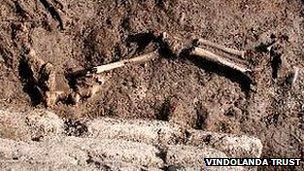Child skeleton at Vindolanda fort 'from Mediterranean'
- Published

The bones were at first thought to be those of a dog
A child from 1,800 years ago whose skeleton was found at a fort in north-east England was from the Mediterranean and probably murdered, an expert said.
The skeleton was unearthed from a shallow pit at the Vindolanda Roman fort, in Northumberland, two years ago.
Dr Trudi Buck, of Durham University, was unable determine whether it was a boy or girl but named it Georgie.
It is believed the child, aged about 10 and who was tied up, died from a blow to the head and the body was concealed.
Foul play is suspected, because human burials in built-up areas were strictly forbidden in Roman times.
'Harsh blow'
When the bones were first discovered, it was thought they were those of a large dog.
The pit in the barracks has been dated to the middle of the 3rd Century, when the Fourth Cohort of Gauls formed the garrison.
At that time, the dead had to be interred or cremated in cemeteries on the outskirts of towns or barracks, so the concealment of a body in this fashion would have been a criminal act.
Dr Buck, a biological anthropologist, said the discovery suggested the young victim was either a child slave or the son or daughter of a soldier serving on Hadrian's Wall - giving more weight to the theory that they took their families with them to Northumberland.
Dr Buck said: "I think this is definitely a murder or other unnatural death because of the way the body was deposited.
"This is very circumstantial, but possibly it was hit over the head with something because we have very good preservation of the body down to wrist bones that are 1cm in size, but not very much of the head.
"Maybe a harsh blow to the head caused a fractured skull."
Tests on the child's tooth enamel, carried out for a National Geographic Channel TV programme, showed Georgie grew up in the Mediterranean.
"It turns out the child is not from the local area and is not even from Britain," Dr Buck said.
"Until the child was at least seven or eight, they have been in southern Europe or even North Africa.
'Very sad'
"This asks lots of questions about who this child was, how did they get from North Africa to northern Britain in the last two years of their life, and then get killed?"
Dr Buck said the Romans' use of child slaves was well-documented, so perhaps that explained how the youngster came to live by Hadrian's Wall.
"It is very sad and goes to show human nature does not change," she said.
"Perhaps there was an accident and the soldiers tried to hush it up. This is a child who was not given any rituals and Romans were very strict on burial in the right place.
"When I was working on it I was very much conscious this was a child and I gave it a name very quickly so I didn't have to keep calling it 'it'."
- Published16 September 2010